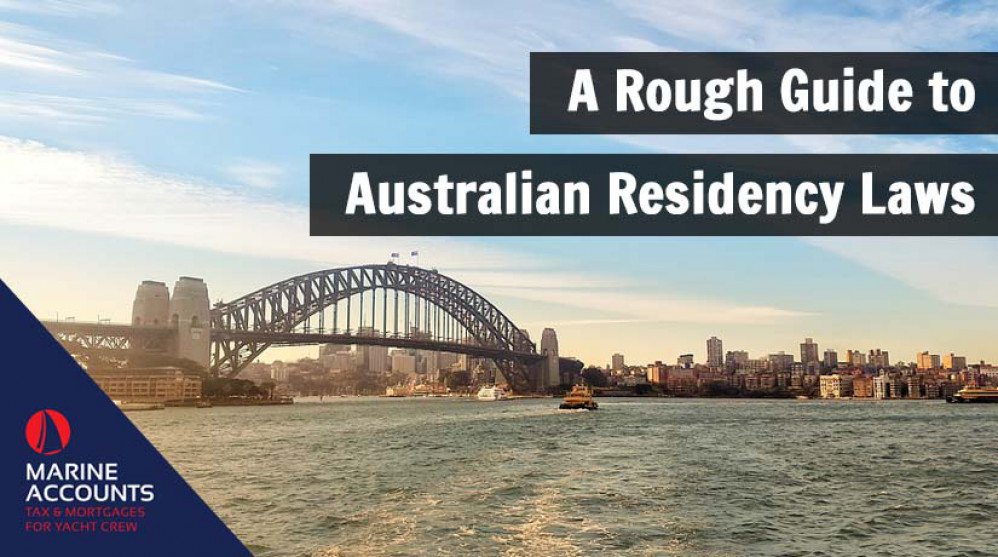A Rough Guide to Australian Residency Laws
- Authors
-
-

- Name
- Patrick Maflin
-

Image source: https://pixabay.com/de/photos/sydney-hafenbrücke-australien-3605033/
The majority of Australian yacht crew when asked if they are you a resident for tax purposes, tend to answer that they are non-resident.
However are these assertions based on fact or simply preconceived ideas on residency?
In our experience the latter tends to apply, as the laws themselves are subjective and require interpretation.
The purpose of this article is to try and debunk some of the myths surrounding residency in Australia and provide a little more clarity on the residency rules.
Read on to find out more or click a jump menus below to skip to a chapter that interests you.
Chapters
- Primary or Ordinary Concepts Test of Residence
- Ordinary Concepts
- Domicile/Permanent Place of Abode Test
- The 183 Day Test
- Commonwealth Superannuation Fund Test
- Conclusion
- Speak to Us or Comment!
If you want to understand how to define your status as resident or non-resident you must first examine the rules that are currently in place and how an individual is qualified under them.
Primary or Ordinary Concepts Test of Residence
Satisfies one of three statutory residence tests:
Ordinary Concepts
Residence according to ordinary concepts is quite different from domicile, nationality and citizenship.
Whether a person resides in Australia is essentially a question of fact and degree thus there is no one rule which will determine the issue in every case.
Individuals can potentially be resident in more than one country at a time.
A person may be held to be resident in Australia, even though living permanently abroad, if this person visits Australia for part of the year or on a regular basis.
Yacht crew for example, will be resident in Australia if they maintain a family home in Australia where they spend time while in Australia, even though they are absent for the majority of the year.
Residency in Australia is further examined in the context of behaviour over a considerable time (6 months) that displays a degree of continuity.
The following factors are useful in describing the quality and character of an individual's behaviour:
- Intention or purpose of the person's presence in Australia
- The extent of the person's family or business/employment ties with Australia
- The maintenance & location of the person's assets
- Individual's social & living arrangements
It is sometimes easier to understand this rule if put into context.
For example, an engineer who accepted a 2 year appointment overseas, but maintained his Australian family home and ties in Australia to which he ultimately returned, was held to be resident according to the ordinary concepts rule (Lyengar 2011 ATC 10-222).

Image source: https://images.pexels.com/photos/40185/mac-freelancer-macintosh-macbook-40185.jpeg
Domicile/Permanent Place of Abode Test
Domicile is a complex concept of general law, but your domicile is usually the country your father considered his permanent home when you were born.
A person whose domicile is in Australia is deemed to be resident of Australia unless the Commissioner is satisfied that the person's permanent place of abode is outside Australia (the domicile/permanent place of abode test).
IT 2650 is the most pertinent tax ruling from the ATO in place for yacht crew.
This ruling examines the factors to be taken into account when determining whether a person who leaves Australia temporarily to live overseas acquires a permanent overseas place of abode there.
The issue that may cause some uncertainty is whether a yacht or ship, contrasted with a fixed dwelling, can constitute a permanent place of abode.
There have been legal authorities which support the position that a yacht or a ship can constitute a permanent place of abode in the right circumstances (Koitaki Para Rubber Estates Limited v FC of T (1941) 64 CLR 241).
However in the taxation ruling (IT 2650), individuals or a family group who 'make do' in temporary accommodation with limited resources and facilities such as in barracks, singles' quarters, aboard ships, oil rigs, or mining towns, will be less likely to be considered to have established a permanent place of abode overseas.
The 183 Day Test
The second statutory residence test, constructive residence in Australia is attributed to a person who is actually present in Australia for more than 183 days a fiscal year.
This test is known as 183 Day Test.
However this rule is not hard and fast.
If a taxpayer spends more than 183 days outside of Australia, this will not mean that they are non-resident.
Commonwealth Superannuation Fund Test
An individual is a resident under the third statutory test if he/she is a contributing member (or is the spouse or child under 16 of a person who is a contributing member) of the superannuation fund for Commonwealth government officers.
Yacht crew need to be particularly mindful of this as case studies have proven that even if you cease to reside in Australia, but retain membership of an Australian government superannuation scheme, you can still be deemed resident as per this test.

Image source: https://pixabay.com/de/vectors/australien-australien-tag-grenzen-1296727/
Conclusion
Australia has one of the hardest residency schemes of the G20 member states.
It is very difficult to establish a position as non-resident without obtaining a ruling from the Commissioner of the ATO.
Rulings of this nature also present their own series of problems, and if the ruling goes against you it is very difficult for it to be overturned.
As demonstrated in this article, it is very hard to apply hard and fast rules that will work for all where residency is concerned.
However, it is possible to significantly minimise the chance of being considered resident in Australia.
The most obvious route is to spend less than 183 days a year in Australia and not be part of a government superannuation scheme.
The transient unpredictable nature of yacht crew precludes the chance of falling foul of the ordinary concepts rule.
However efforts should still be made on behalf of an individual to not establish behavioural patterns over considerable time.
Individuals who are most susceptible for this are those who work on rotation.
In our professional opinion, we would always advise that you do not establish a behavioural pattern that could be interpreted for the purpose of this rule and thus deem you to be resident.
The Domicile/Permanent Place of Abode Test is the most common rule that yacht crew are deemed to be resident under.
It is very hard for an individual working on a yacht to establish the necessary degree of permanence to prevent this rule coming into effect.
The IT2650 tax ruling clearly states that individuals aboard ships, oil rigs, or mining towns, will be less likely to be considered to have established a permanent place of abode overseas.
However there have been successful cases that have managed to overturn this ruling such as (Koitaki Para Rubber Estates Limited v FC of T (1941) 64 CLR 241).
Speak to Us or Comment!
If you have concerns about your yachting income and how this affects your Australian residency status, we would like to hear from you. Get in touch with us today or let us know your thoughts in the comments section below.
Liked this article? Try reading:
Australian Taxation and Yacht Crew - A Tough Relationship
Any advice in this publication is not intended or written by Marine Accounts to be used by a client or entity for the purpose of (i) avoiding penalties that may be imposed on any taxpayer or (ii) promoting, marketing or recommending to another party matters herein.


